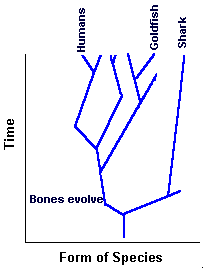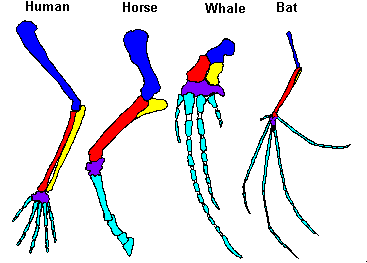You may be surprised to learn that goldfish are more closely related
to humans than to sharks! That's because sharks do not have bones,
they only have "skeletons" of cartilage. Goldfish and humans
evolved from a common ancestor that had evolved a proper skeleton
of bone so goldfish and humans share the homologous structures
of true bones. The large number of similarities between sharks
and goldfish is due to their shared lifestyle so those are analogous
similarities (caused by converging evolution - or more properly, they were adaptations that did not so much converge as remained the same over millions of years). Granted, it is
hard to tell which similarities shared between goldfish and sharks
are homologous and which are analogous. It takes an expert with
a great deal of training to catch those subtle differences and
the fossil record reinforces that knowledge.
Perhaps this graph will help you understand why goldfish are more
closely related to humans than sharks.
Notice the branching patterns in the chart.
Early in evolution, many millions of years ago, a major division
occurred. Soon after that split one group (on the left) evolved
true bones and passed that trait onto all its descendants. Bones
are a homologous similarity shared between goldfish and humans.
The other group (on the right) did not evolve bones and could
not inherit them because they had broken away from that branch
of the "family tree" after bones had evolved.
| 
|
These two divisions allow us to split animals up into "bony"
and "nonbony" animals. That is a split based upon a
similarity passed on by ancestry - a homologous similarity. Sharks
are nonbony while humans and goldfish are bony. Goldfish have
a similar form to sharks because of their similar lifestyle (so
in this graph they are more towards the side of the sharks in
form) but their ancestry (the path of the blue line) shows that
goldfish and humans shared a common ancestor (a bony one) long
ago.
So, goldfish are more closely related to humans than they are
to sharks!
(Phew!)
Don't let this graph (example) worry you. It is meant to show
you that things are not always as simple as they may at first
seem. Indeed, most biology textbooks are quick to group sharks
and fish together into a single group called "fish".
However, from a purely evolutionary standpoint, the "fish" group (called "Pisces") should be properly subdivided
into "bony fish" (called "teleosts") and nonbony
fish" (called "elasmobranchs"). We humans (and all other vertebrates) are descendents of the "bony fish" line.
Now let's get back to some homologous similarities that are easier to understand
and learn more about how they can teach us about evolution.
|
This drawing shows limbs from several mammals and I have identified
the humerus (blue) ulna (yellow), radius (red), carpels (purple)
and digits (light blue).
The human arm should be familiar to you. Notice the way the bones
in the limb have evolved into different shapes in order to accommodate
the lifestyles of each animal. Although these changes produce
radically different limb structures, their underlying bones are
still there - only their size and shape have changed.
| 
|
Mammals like the whale or horse have five digits as embryos but
they eventually give way to the structures you see here. Why should
a whale have five digits as an embryo and four digits as an adult?
Why does a whale have any digits at all? Goldfish and sharks do
not have hands (fins) like those of a whale. Why does the horse
have a single digit when born but five digits as an embryo?
Why does the bat have five digits? A bat's wing might be just
as good, perhaps better, with more or fewer digits, so why five?
All these peculiar similarities and embryological changes are
due to the fact that all mammals evolved from a common ancestor
that had five digits and a limb that included a humerus, ulna
and radius. Each of these bones has a homologous structure in
each mammal because all mammals descended from a common ancestor.
That is the logical explanation.
Homologies do not stop with anatomy. They extend to all levels
of an organism. What is the smallest, most fundamental "thing"
that an organism inherits from its descendants? It is also the
foundation upon which the entire organism (including its anatomy)
is based?
Once you've come up with something that you think might fit that descriptions, check it out on the next page.
This work was created by Dr Jamie Love  and
and  licensed under a Creative Commons Attribution-ShareAlike 4.0 International License.
licensed under a Creative Commons Attribution-ShareAlike 4.0 International License.
If you like, you can return to the Home Page.


 and
and  licensed under a Creative Commons Attribution-ShareAlike 4.0 International License.
licensed under a Creative Commons Attribution-ShareAlike 4.0 International License.